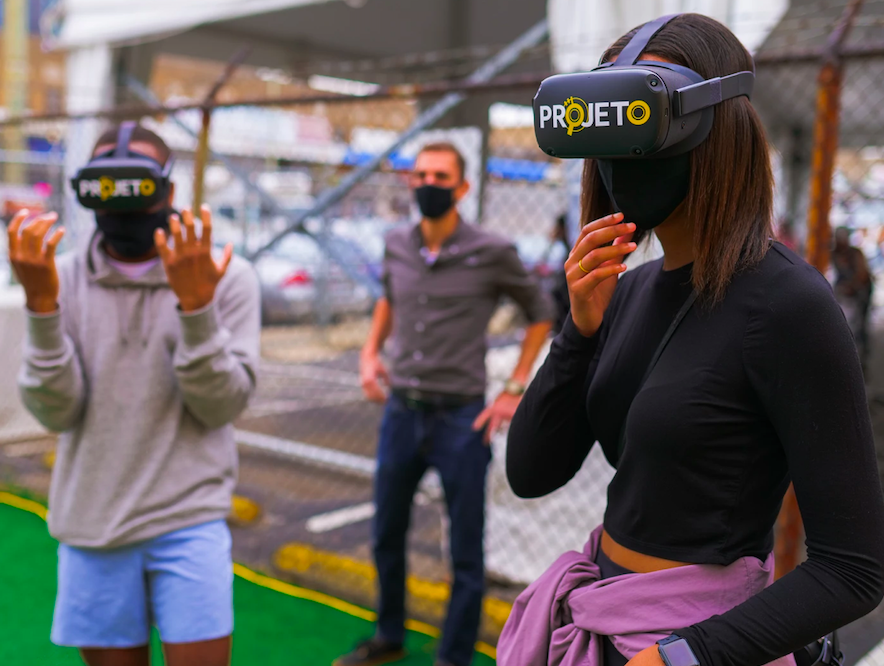I’ll never forget meeting that robot.
I had spent over an hour delicately unpacking my Oculus Rift headset, installing and updating software on my ostentatiously overpowered desktop computer, and calibrating sensors to my extraordinarily efficient bedroom, which the software insisted could not reasonably be as small as I was reporting. When I finally put on the headset, the trappings of my cramped, cluttered apartment melted away and I found myself in a cramped, cluttered trailer — only it was on the moon, I think. A small robot appeared, and together we caught butterflies and danced with maracas and fired off toy rockets. I reveled in naïve wonderment typically reserved for middle schoolers at summer camp. My average, complicated, and unmistakably real life was doubtless waiting for me just outside, and for a blissful afternoon, that was no concern of mine.
It’s 2021, and we’re sitting on technology that can utterly immerse someone in another world — one that’s bigger than any video game, bigger than the entertainment industry. So why hasn’t this technology become a part of our everyday lives?
It’s easy to envision an office full of headset-wearing workers, waving away at virtual spreadsheets, but the jump to a fully virtual office is a monumental ask at this point. Current hardware can realize a customizable desk environment with unlimited, resizable work surfaces in a 3D space, but the productivity gain of flexible work surfaces would be offset by the ergonomic trauma of eight hours wearing goggles and navigating unfamiliar input systems.
That’s not to say it isn’t coming. This is a field to watch, particularly in regard to augmented reality headsets, which allow the user to see the world around them with holographic overlays. Once workers can reap some of the benefits of a virtual workspace without losing access to their mouse, keyboard, and coworkers, a transition will feel much more natural. Augmented reality headsets do exist, but the field is not as developed as virtual reality, so the options are fewer, less established, and more expensive.
Virtual reality has seeped into business, and its foothold is growing every day. Hardware manufacturer Oculus was one of the biggest players in introducing mainstream virtual reality to the video game industry. Now, owned by Facebook, they have a separate, business-focused division with its own licensing, support, and marketing. They highlight virtual training programs, citing faster, cheaper, and better results than traditional in-person training programs. Their website includes cherry-picked studies boasting the advantages of VR hardware, including improved efficiency when training salespeople and better information retention in medical students. Even a small boost in employee productivity can quickly justify the cost of maintaining a small fleet of VR-capable devices; the resources some companies spend on a single team-building exercise could secure a versatile VR system that could contribute to employee morale and skill building in limitless ways.
Pico, a major player in the VR hardware industry in China, has brought their business lineup — and only their business lineup — to the United States. While their products are quite similar to those of Oculus, they’ve chosen to highlight client-facing use cases such as virtual experiences to calm patients while at a dentist’s office, entertain passengers on a flight, or engage patients undergoing therapy. Any business that deals with clients has a vested interest in making a good impression. If client-facing VR experiences can’t directly enhance a product, they can still have an enormous impact on marketing. Potential clients can take a factory tour, interact with a design sample, meet the people behind the product — memorable experiences that can’t be captured in a brochure. (And it’s a nice tech flex to have VR options available.)
At Urban District Realty, we’re bringing the immersion and engagement of virtual reality to property showings. Virtual tours are commonplace in real estate, and most clients are willing to forgo a traditional showing in favor of 360° photos that can be quickly sifted through. We created our showing system, PROJETO, to marry the convenience of flipping through virtual tours with that meet-the-robot moment so clients can take off their headsets and say, “You don’t understand, I was there.”
Of course, making a great tool isn’t enough if people won’t use it. We prioritized accessibility in PROJETO; clients simply put on a headset and our staff leads the experience. As straightforward as that is, though, some people still aren’t comfortable wearing a virtual reality headset. We anticipated that and included other ways that clients can interact with our content, but it’s frustrating to invest in a great product that people won’t even try.
So why is this amazing technology a hard sell? Based on what we’ve seen, many people are naturally hesitant to try new things, and some of the braver individuals have been put off by past experiences. Badly crafted content can not only leave users disinterested but can induce discomfort similar to motion sickness, which can then breed distrust in the hardware itself. VR content creators are shaping one of the most important inventions of our lifetime, and it’s not a responsibility to be taken lightly.
Virtual reality is the future — a future full of potential, creativity, power, and responsibility. In the current landscape, integrating VR into a business requires creativity, but those creative investments are rewarded with accolades as a frontrunner in innovation and technology. In five years, businesses will be buying VR solutions from the companies that create them today. And in 15 years, any business without VR tech will be falling behind.







